
Bicycle handlebar
Encyclopedia

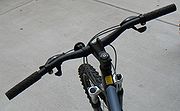
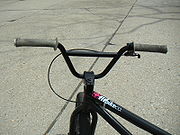
Bicycle
A bicycle, also known as a bike, pushbike or cycle, is a human-powered, pedal-driven, single-track vehicle, having two wheels attached to a frame, one behind the other. A person who rides a bicycle is called a cyclist, or bicyclist....
s; the equivalent of a steering wheel
Steering wheel
A steering wheel is a type of steering control in vehicles and vessels ....
. Besides steering, handlebars also often support a portion of the rider's weight, depending on their riding position, and provide a convenient mounting place for brake levers
Bicycle brake systems
A bicycle brake is used to slow down or stop a bicycle. There have been various types of brake used throughout history, and several are still in use today...
, shift levers
Shifter (bicycle part)
A bicycle shifter or gear control or gear levers is a component used to control the gearing mechanisms and select the desired gear ratio. Typically, they operate either a derailleur mechanism or an internal hub gear mechanism. In either case, the control is operated by moving a cable that connects...
, cyclocomputer
Cyclocomputer
A cyclocomputer or cyclometer is a device mounted on a bicycle that calculates and displays trip information, similar to the instruments in the dashboard of a car. The computer with display, or head unit, usually is attached to the handlebar for easy viewing.-History:In 1895 Curtis Hussey Veeder...
s, bells
Bicycle bell
A bicycle bell is a bell mounted on a bicycle for warning pedestrians and other cyclists. They are a required piece of equipment is some jurisdictions. They usually mounted on the handlebars and thumb activated...
, etc. Handlebars are attached to a bike's stem which in turn attaches to the fork
Bicycle fork
A bicycle fork is the portion of a bicycle that holds the front wheel and allows the rider to steer and balance the bicycle. A fork consists of two fork ends which hold the front wheel axle, two blades which join at a fork crown, and a steerer or steering tube to which the handlebars attach ...
.
Types of handlebar
Handlebars come in a variety of types designed for particular types of riding.Drop

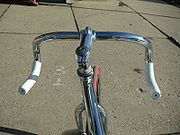
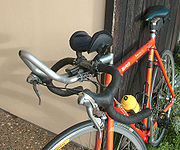
Road bicycle
The term road bicycle is used to describe bicycles built for traveling at speed on paved roads. Some sources use the term to mean racing bicycle...
or track
Track bicycle
A track bicycle or track bike is a bicycle optimized for racing at a velodrome or outdoor track. Unlike road bicycles, the track bike is a fixed-gear bicycle and so has a single gear and neither freewheel nor brakes. Tires are narrow and inflated to high pressure to reduce rolling resistance...
bicycles, may have a shallow or deep drop. Drop bars may have one or two longitudinal indentations so that the brake and shift cables protrude less when they are wrapped under the bar tape. They may also have a flattened top section.
Track
Track drop bars are a variation of bars designed for the typical riding positions of track bicycle racers. Track drops are characterized by large, sweeping ramps, effectively precluding the top and brake hood hand positions, but promoting the rider's use of the ends, or "hooks". Track bars are designed for use without brake levers, but recently experienced a surge in popularity on use with fixed gear bikes, and as such have been adapted to fit levers and hand positions.
Ergo or anatomic
The shape of the drop may be a simple, traditional curve, or it can have a flat spot (straight section) which some riders find to be more comfortable for their hands. These bars may be described as ergo or anatomic.
Randonneur
Drop bars that rise slightly from the centre in a shallow U, and the drop portion of the bars is set wider than the curve at the top. Designed to be slightly more comfortable than a straight drop bar for bicycles used in Audax
Audax (cycling)
Audax is a cycling sport in which participants attempt to cycle long distances within a pre-defined time limit. Audax is a non-competitive sport: success in an event is measured by its completion. Audax has its origins in Italian endurance sports of the late nineteenth century, and the rules were...
riding.
Drop-in
At one time, manufactures and racers experimented with drop-in bars that had an additional extension in toward the head tube
Head tube
Most bicycles, tricycles and motorcycles have a tubular frame. The front fork pivots within the head tube . On a motorcycle, the "head tube" is normally called the steering head...
at the rear end of the drops. This was intended to offer an even more aerodynamic position, due to low and narrow placement of the hands, than just the drops, while still remaining legal for mass-start races. Their popularity has since waned.
Flat or Riser
"Flat" or "riser" bars are the standard handlebars equipped on mountain bikeMountain bike
A mountain bike or mountain bicycle is a bicycle created for off-road cycling. This activity includes traversing of rocks and washouts, and steep declines,...
s, hybrid
Hybrid bicycle
A hybrid bicycle is a bicycle designed for general-purpose utility and commuting on a wide variety of surfaces, including paved and unpaved roads, paths and trails...
s, and recently on fixed-gear bicycle
Fixed-gear bicycle
A fixed-gear bicycle is a bicycle that has no freewheel, meaning it cannot coast, as the pedals are always in motion when the bicycle is moving....
s and flat bar road bike
Flat bar road bike
A flat bar road bike is a relatively new style of bicycle. It is simply a road bike often fitted with MTB-style shifters, brake levers and a flat handlebar. This combination provides a light, fast bike with a more upright and neutral riding position. A flat bar road bike is most commonly used for...
s. A flat bar is a nearly-straight tube, slightly bent toward the rider. A riser is a variation in which the outer sections of the bars rise from the center clamp area. Flat and riser bars may be appended with bar ends, providing more hand positions. The bullmoose style is a variation on the flat bar, common on early mountain bikes, where the stem and bars are a single unit and where the single top section of the stem would be, there are instead 2 bars joined at the quill to the rear and connected to the conventional handlebar section in the front, at two off-center locations, forming a triangle.

Upright or North Road
One of the oldest type of handlebars, this type of bar was named after the North Road Cycling ClubFrederick Thomas Bidlake
Frederick Thomas Bidlake was an English racing cyclist of the late 19th century who became one of the most notable administrators of British road bicycle racing during the early 20th century. The annual Bidlake Memorial Prize, was instituted in his memory...
in London
London
London is the capital city of :England and the :United Kingdom, the largest metropolitan area in the United Kingdom, and the largest urban zone in the European Union by most measures. Located on the River Thames, London has been a major settlement for two millennia, its history going back to its...
. North Road bars are swept back toward the rider, with each grip ending nearly parallel to each other and the bike. They were used on three-speed and single speed Raleighs
Raleigh Bicycle Company
The Raleigh Bicycle Company is a bicycle manufacturer originally based in Nottingham, UK. It is one of the oldest bicycle companies in the world. From 1921 to 1935 Raleigh also produced motorcycles and three-wheel cars, leading to the formation of the Reliant Company.-Early years:Raleigh's history...
, Schwinns
Schwinn Bicycle Company
The Schwinn Bicycle Company was founded by German-born mechanical engineer Ignaz Schwinn in Chicago in 1895. It became the dominant manufacturer of American bicycles through most of the 20th century and today it is a sub-brand of Pacific Cycle, owned by the multi-national conglomerate, Dorel...
, and other three-speed bikes well into the 1980s, as well as various European utility bikes
European city bike
A European city bike, or simply city bike is a bicycle designed for frequent short, moderately paced rides through relatively flat urban areas...
and roadsters
Roadster (bicycle)
A roadster, aka English roadster, is a type of utility bicycle once common in Britain and still very common in Asia, Africa, Denmark and the Netherlands, however, during the past several years, traditionally styled roadster bicycles have gained considerable popularity in the United States and...
. They have recently enjoyed a resurgence in popularity on some hybrid bicycle
Hybrid bicycle
A hybrid bicycle is a bicycle designed for general-purpose utility and commuting on a wide variety of surfaces, including paved and unpaved roads, paths and trails...
s, city bikes
Hybrid bicycle
A hybrid bicycle is a bicycle designed for general-purpose utility and commuting on a wide variety of surfaces, including paved and unpaved roads, paths and trails...
, and comfort models
Hybrid bicycle
A hybrid bicycle is a bicycle designed for general-purpose utility and commuting on a wide variety of surfaces, including paved and unpaved roads, paths and trails...
. They are also known as "Townie", or "Tourist" bars. North Road bars can easily be inverted to give a slight amount of drop when a more aggressive riding posture is desired.

Porteur
Porteur bars sweep backwards towards the rider with a slight drop. They are designed to accommodate front-mounted racks or baskets in order to haul cargo and are usually found on dedicated Porteur bicyclePorteur bicycle
A porteur bicycle is a kind of cargo bicycle designed for carrying cargo loads on a platform rack attached to the fork. Porteur bicycles are similar to butcher's bikes, baker's bikes, low gravity bicycles and delibikes, but they include design differences which make them a distinct category...
s.
Touring or trekking
Sometimes referred to as "Butterfly" bars, these are commonly encountered in continental Europe. They typically consist of a broken figure-of-eight arrangement mounted horizontally on the stem. This style of bar allows the rider to remain relatively upright while at the same time providing a wide range of hand positions for comfort on long duration rides. A variation of the Butterfly bar is fitted to 'P-type' Brompton folding bicycles. It differs from other Butterfly bars in that it is fitted vertically rather than horizontally.Triathlon or aero
Triathlon bars or aerobars include various styles of aerodynamic handlebars for racing bicycleRacing bicycle
A racing bicycle, also known as a road bike, is a bicycle designed for competitive road cycling, a sport governed by according to the rules of the Union Cycliste Internationale...
s and particularly time trial bicycle
Time trial bicycle
A time trial bicycle is a racing bicycle designed for use in an individual or team time trials raced on roads. Special time trial bikes also exist for use in a velodrome....
s. Included are narrow, bolt-on extensions that draw the body forward into a tucked position, pursuit bars that spread the arms of the rider but drops the torso into a slightly lower position, and integrated units that combine elements of both designs.
Triathlon bars are commonly used in triathlon
Triathlon
A triathlon is a multi-sport event involving the completion of three continuous and sequential endurance events. While many variations of the sport exist, triathlon, in its most popular form, involves swimming, cycling, and running in immediate succession over various distances...
s and time trial
Time trial
In many racing sports an athlete will compete in a time trial against the clock to secure the fastest time. In cycling, for example, a time trial can be a single track cycling event, or an individual or team time trial on the road, and either or both of the latter may form components of...
events on road and track. However, they are illegal in most mass start road races or any other event where drafting
Drafting (racing)
Drafting or slipstreaming is a technique where two vehicles or other moving objects are caused to align in a close group reducing the overall effect of drag due to exploiting the lead object's slipstream...
is permitted because, while aerodynamically advantageous, they tend to draw the hands away from brakes
Bicycle brake systems
A bicycle brake is used to slow down or stop a bicycle. There have been various types of brake used throughout history, and several are still in use today...
, make the rider slightly more unstable on the bike, and can be dangerous in the event of an accident. Further, they are not useful in sprints or shorter climbs where power is of greater importance than aerodynamics.
Specialized shift levers (known as bar-end shifters) do exist that can be installed on some triathlon bars so that they can be reached without moving the hands from the aerodynamic position. The complementary brake levers in this handlebar configuration are placed in the ends of the accompanying pursuit bars.
Aero bars are a recent addition to road racing time trials, with Greg LeMond
Greg LeMond
Gregory James LeMond is a former professional road bicycle racer from the United States and a three-time winner of the Tour de France. He was born in Lakewood, California and raised in Reno, Nevada....
first using them in the 1989 Tour de France
1989 Tour de France
The 1989 Tour de France was the 76th Tour de France, a race of 21 stages and a prologue, over 3285 km in total. In the closest tour in history, Greg LeMond was behind by 50 seconds at the start of the final stage, a time trial into Paris. LeMond rode for an average speed of 54.55 km/h ,...
. In a controversial time trial on the final day, LeMond used them to beat yellow jersey wearer Laurent Fignon
Laurent Fignon
Laurent Patrick Fignon was a French professional road bicycle racer. He won the Tour de France in 1983 and in 1984. He missed winning it a third time, in 1989, by 8 seconds, the closest margin ever to decide the tour. He also won the Giro d'Italia in 1989, after having been the runner-up in 1984,...
by 58 seconds, changing a 50 second deficit into an 8 second lead. Fignon protested at the use of these bars but was unsuccessful.
Pursuit
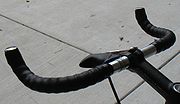
Track bicycle
A track bicycle or track bike is a bicycle optimized for racing at a velodrome or outdoor track. Unlike road bicycles, the track bike is a fixed-gear bicycle and so has a single gear and neither freewheel nor brakes. Tires are narrow and inflated to high pressure to reduce rolling resistance...
, single-speed
Single-speed bicycle
A single-speed bicycle is a type of bicycle with a single gear ratio. These bicycles are without derailleur gears, hub gearing or other methods for varying the gear ratio of the bicycle....
, and fixed-gear
Fixed-gear bicycle
A fixed-gear bicycle is a bicycle that has no freewheel, meaning it cannot coast, as the pedals are always in motion when the bicycle is moving....
bicycles.
This style of handlebar is named after the discipline of track racing where it was originally used, and has the common nickname of "Bullhorn bars" for their appearance.
Bullhorn bars may be constructed simply by cutting the drops off drop bars and then mounting them upside down so that the remaining start of the drop provides a slight upward hook for resting the hands, although this does not provide as much forward extension (reach) or lowering (if desired, normally for time-trial based use) as purpose made bullhorns. These are sometimes called "Flopped and Chopped" or "Flipped and Clipped" bars, and if this is to be done, care should be taken to properly remove the sharp edges from the cuts, and to properly tape and plug the bar ends for safety purposes.
BMX
BMX style handlebars, as used on BMXBMX
Bicycle motocross or BMX refers to the sport in which the main goal is extreme racing on bicycles in motocross style on tracks with inline start and expressive obstacles, and it is also the term that refers to the bicycle itself that is designed for dirt and motocross cycling.- History :BMX started...
bicycles, have more rise than straight bars and usually have a cross brace to provide rigidity and strength.
Cruiser
Cruiser handlebars, as used on cruiser bicycleCruiser bicycle
Cruiser bicycles, also known as beach cruisers, combine balloon tires, upright seating posture, single-speed drivetrains, and straightforward steel construction with expressive styling...
s, tend to be long and slope towards the rear of the bicycle so that the rider can sit upright.

Moustache
Moustache handlebars curve forward from the stem and then back towards the rider. This style was designed in the early 90s by Grant PetersenGrant Petersen
Grant Petersen is a bicycle designer and the founder of Rivendell Bicycle Works. He was U.S. marketing director for Bridgestone Cycle , Inc...
for the Bridgestone XO-1, based on the semi-drop bars used by schoolchildren in Japan.
Ape hangers
Ape hanger handlebars rise far above the stem so that the rider must reach up to use them, hence the name. This style of bicycle handlebar became wildly popular in the 1960s after the introduction of wheelie bikeWheelie bike
A wheelie bike, also called a muscle bike, high-riser, or banana bike, is a type of stylized children's bicycle designed in the 1960s to resemble a chopper motorcycle and characterized by ape hanger handlebars, a banana seat with sissy bar, and small wheels. Notable examples include the Schwinn...
s such as the Schwinn Sting-Ray, Raleigh Chopper
Raleigh Chopper
The Raleigh Chopper is a children's bicycle, a wheelie bike, manufactured and marketed in the 1970s by the Raleigh Bicycle Company of Nottingham, England. Its unique design became a true 70s cultural icon, and is fondly remembered by many who grew up in that period...
, and other highly stylized youth bicycles that imitated the appearance of drag-racing or chopper motorcycles
Chopper (motorcycle)
A chopper is a type of motorcycle that was either modified from an original motorcycle design or built from scratch to have a hand-crafted appearance. The main features of a chopper that make it stand out are its longer frame design accompanied by a stretch front end...
of the day. They are still frequently seen on lowrider bicycle
Lowrider bicycle
A lowrider bicycle is a highly customized bicycle with a long wheelbase and stylings inspired by lowrider cars. These bikes often feature a long, curved banana seat with a sissy bar and very tall upward-swept ape hanger handlebars...
s.
As the result of intense pressure by consumer advocacy organizations to outlaw such handlebars, beginning with Public Citizen
Public Citizen
Public Citizen is a non-profit, consumer rights advocacy group based in Washington, D.C., United States, with a branch in Austin, Texas. Public Citizen was founded by Ralph Nader in 1971, headed for 26 years by Joan Claybrook, and is now headed by Robert Weissman.-Lobbying Efforts:Public Citizen...
in 1971, some U.S. and other jurisdictions actually have regulations on how high the hand grips may be above the seat. For example, the European Standard EN 14764:2005 contains:
- 4.7 Steering
- 4.7.1 Handlebar — Dimensions
-
-
- The handlebar shall have an overall width between 350 mm and 1000 mm unless national regulations dictate otherwise. The vertical distance between the top of the handlebar grips, when assembled to the highest riding position according to the manufacturer's instructions, and the seat surface of the saddle at its lowest position shall not exceed 400 mm.
-
National or International Standards such as this may have legal force concerning sale of items, while not necessarily being legally binding as regards the use of the items, depending on the jurisdiction.

Recumbent
Recumbent bicycleRecumbent bicycle
A recumbent bicycle is a bicycle that places the rider in a laid-back reclining position. Most recumbent riders choose this type of design for ergonomic reasons; the rider's weight is distributed comfortably over a larger area, supported by back and buttocks...
s, due to their wide variety, are often equipped with handlebars seen nowhere else. These include handlebars with a very far reach, similar to ape hangers (see above) but mounted less vertically, and handlebars designed for under-seat steering, called Whatton bars.
Whatton
Whatton bars loop behind the legs of penny-farthingPenny-farthing
Penny-farthing, high wheel, high wheeler, and ordinary are all terms used to describe a type of bicycle with a large front wheel and a much smaller rear wheel that was popular after the boneshaker, until the development of the safety bicycle, in the 1880s...
riders so that they can still keep their feet on the pedals and also be able to leap feet-first forward off the machine. These are also used on recumbent bicycles for under-seat steering.
Design goals
The design goals of handlebars varies depending on the intended use of the bicycle. Common to all bicycles are the goals of- Providing necessary leverLeverIn physics, a lever is a rigid object that is used with an appropriate fulcrum or pivot point to either multiply the mechanical force that can be applied to another object or resistance force , or multiply the distance and speed at which the opposite end of the rigid object travels.This leverage...
age to steer the bicycle and generate power. - Providing a comfortable ride by damping road/offroad vibration
- Providing a mount point for any brakes and gear levers.
Racing/touring and triathlon bars have additional goals
- Enabling the rider to assume an aerodynamic position.
- Enabling the rider to change body positions during long rides, preventing fatigueFatigue (physical)Fatigue is a state of awareness describing a range of afflictions, usually associated with physical and/or mental weakness, though varying from a general state of lethargy to a specific work-induced burning sensation within one's muscles...
. - Enabling aerodynamic routing of brake/gear cables.
Mountain bike handlebar design goals have less focus on aerodynamics, more on negotiating terrain:
- Providing enough control to manoeuvre the front of the bicycle over obstacles.
- Being strong enough to withstand the extra forces generated in some activities/crashes.
- Optionally: not significantly increasing vehicle weight.
BMX/Trials bike bars have similar needs to mountain bikes:
- Providing the control needed to execute advanced cycling manoeuvres.
- Withstanding the forces generated in the process.
Materials
Handlebars are most commonly made of aluminium alloyAluminium alloy
Aluminium alloys are alloys in which aluminium is the predominant metal. The typical alloying elements are copper, magnesium, manganese, silicon and zinc. There are two principal classifications, namely casting alloys and wrought alloys, both of which are further subdivided into the categories...
s, but are also often made from steel
Steel
Steel is an alloy that consists mostly of iron and has a carbon content between 0.2% and 2.1% by weight, depending on the grade. Carbon is the most common alloying material for iron, but various other alloying elements are used, such as manganese, chromium, vanadium, and tungsten...
, carbon fiber
Carbon fiber
Carbon fiber, alternatively graphite fiber, carbon graphite or CF, is a material consisting of fibers about 5–10 μm in diameter and composed mostly of carbon atoms. The carbon atoms are bonded together in crystals that are more or less aligned parallel to the long axis of the fiber...
or titanium
Titanium
Titanium is a chemical element with the symbol Ti and atomic number 22. It has a low density and is a strong, lustrous, corrosion-resistant transition metal with a silver color....
.
Width
Drop bars come in a variety of widths from 34 cm to 50 cm. Usually a rider will pick a bar that approximately matches their shoulder width so that their arms can be approximately parallel. The width is measured at the end of the drop section but the exact method varies from manufacturer to manufacturer. Some measure from outside edge to outside edge (e.g. Deda, ITM, TTT) whereas others measure from center to center (e.g. Cinelli, Profile Design, Ritchey, Salsa). The figure returned by measuring outside to outside tends to be 2 cm greater than measuring center to center for the same handlebar.Clamp diameter
Care is needed when choosing a handlebar to match a stem, or vice-versa, as there are several standards. The ISO standard for the clamping area of a handlebar is 25.4 mm (1"), which is used on mountain bikes and many Japanese-made road handlebars. However, the Italian unofficial standard is 26.0 mm, which is the most common clamp size for road bars. There are also intermediate sizes such as 25.8 mm to try and achieve compatibility with either an ISO or Italian stem, and the old Cinelli-specific size of 26.4 mm. In practice, many modern stems with removable faceplates are quite accommodating of slight differences in handlebar clamp size, but the older type of stem with a single pinch bolt must be accurately matched. In the days of quill stems, a road stemwas clearly identifiable from its "7" shape, but nowadays it can be hard to tell the difference between a "road" (26.0 mm) and "MTB" (25.4 mm) stem. Manufacturers frequently omit the clamp size from advertising or packaging.A new standard is an "oversize" 31.8 mm or 31.7 mm (1.25") clamp for both MTB and road bars. This is popular on mountain bikes, especially those with a focus on "all mountain" and "downhill" activities, as the stem and handlebars can be stronger. This clamp diameter is taking over from the previous mix of sizes on road bicycles with drop-bars. On these stems, standard brake levers can be used as it is only the central section that is oversized. although other accessories that mount near the stem also need to be oversized to fit (some brackets are adjustable). Shims are available to fit a 31.8 mm stem to either a 25.4 mm or 26.0 mm bar, so many new models of stems are oversize-only.
BMX style handlebars require a clamp diameter of 22.2 mm (7/8" 0.875") and are therefore incompatible with any non-BMX specific stem.
Handlebar coverings

Tape
There are many types of handlebar tape:- PolyurethanePolyurethaneA polyurethane is any polymer composed of a chain of organic units joined by carbamate links. Polyurethane polymers are formed through step-growth polymerization, by reacting a monomer with another monomer in the presence of a catalyst.Polyurethanes are...
tape, introduced in the last few years, provides cushioning. - Composite rubber tape
- Cork tape, padded tape, provides cushioning but less durable.
- Bike ribbon, plastic padded tape with smooth waterproof surface.
- Benotto "Cello-Tape", made from plastic, popular in the 1970s and 1980s. Compared with other types of handlebar tape it is relatively thin and is unpadded; it does not provide any cushioning from road vibrations. However it is long lasting, does not absorb water, was available in a vast range of colours and stays clean. Similar types of "shiny tape" exist.
- Cotton tape, unpadded woven cotton tape with adhesive backing, similar to twill tapeTwill tapeTwill tape is a flat twill-woven ribbon of cotton, linen, polyester, or wool.Twill tape is available in various widths, generally up to 1 inch , and a wide range of colors....
. - LeatherLeatherLeather is a durable and flexible material created via the tanning of putrescible animal rawhide and skin, primarily cattlehide. It can be produced through different manufacturing processes, ranging from cottage industry to heavy industry.-Forms:...
wrap, for example by Brooks EnglandBrooks EnglandBrooks England is a bicycle saddle manufacturer in Smethwick, Birmingham, England. It has been making leather bicycle saddles since 1866, when it was founded in Hockley, Birmingham.... - An inner tube can be cut and wrapped as well
- A foam rubber tube has been used on inexpensive bikes.
Tape can be applied in several ways, either wrapped from the ends towards the stem or starting near the stem and wrapped towards the ends. The tape is usually held in place at the ends with the bar-end plugs. The other end of the tape can be help in place with adhesive tape, usually electrical insulation tape or, if started near the stem, by first wrapping a few turns towards the stem before reversing direction to anchor it. A figure-eight can be made around the brake lever clamp to completely cover the bar, or a small, separate piece of tape can be place on the back side to cover the small v-shaped section that might otherwise be left bare. Strips of bar gel may optionally be applied to the handebars prior to applying the tape in order to reduce vibration transmission and increase comfort.
Grips
Grips are usually made of firm or soft plasticPlastic
A plastic material is any of a wide range of synthetic or semi-synthetic organic solids used in the manufacture of industrial products. Plastics are typically polymers of high molecular mass, and may contain other substances to improve performance and/or reduce production costs...
, foam
Foam
-Definition:A foam is a substance that is formed by trapping gas in a liquid or solid in a divided form, i.e. by forming gas regions inside liquid regions, leading to different kinds of dispersed media...
, gel
Gel
A gel is a solid, jelly-like material that can have properties ranging from soft and weak to hard and tough. Gels are defined as a substantially dilute cross-linked system, which exhibits no flow when in the steady-state...
, or sometimes leather
Leather
Leather is a durable and flexible material created via the tanning of putrescible animal rawhide and skin, primarily cattlehide. It can be produced through different manufacturing processes, ranging from cottage industry to heavy industry.-Forms:...
. depending on expected use or desired price. They may be simply smooth and round or molded to fit the shape of a human hand better. Foam grips can be applied by submerging them under water and then inflate them with 200,000 Pa
Pascal (unit)
The pascal is the SI derived unit of pressure, internal pressure, stress, Young's modulus and tensile strength, named after the French mathematician, physicist, inventor, writer, and philosopher Blaise Pascal. It is a measure of force per unit area, defined as one newton per square metre...
(30 psi) air while massaging them onto the handlebar. Plastic grips can be heated in water and punched onto the handlebar.
Plugs
Handlebars with open ends should have handlebar plugs fitted in the open ends for safety reasons. These can be made of metal, usually steel, or plastic. Without them, the end of the bar can cause serious injury upon hard impact with soft tissue. Plugs are also required by competitive cycling governing bodies.Bar ends

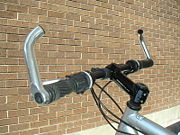
In cycling
Cycling
Cycling, also called bicycling or biking, is the use of bicycles for transport, recreation, or for sport. Persons engaged in cycling are cyclists or bicyclists...
, bar ends are extensions at the ends of the bicycle handlebars. Usually fitted onto mountain bike
Mountain bike
A mountain bike or mountain bicycle is a bicycle created for off-road cycling. This activity includes traversing of rocks and washouts, and steep declines,...
s with straight handlebars, they extend away from the handlebars and allow the rider to vary the type of grip and posture that they use during a ride. They are especially effective when climbing out of the saddle, because they increase leverage. Bar ends can also improve comfort for the rider due to the neutral position of the hands (palms inward) which places marginally less stress upon the musculature, and by providing more than one place to rest hands on a long journey.
Some handlebars have bar ends welded onto them but most are clamped to the end of the bar. They are available in many shapes and sizes, such as stubby models that are around 100 mm in length to ones that curve around so as to provide even more hand positions. It is also possible to purchase combined ergonomic hand grips with integrated bar-ends
Bar ends were very popular on mountain bikes from the early 1990s until the late 1990s, when upswept "riser bars" came back into fashion; the combination of riser bars and bar ends is rarely seen.
Bar ends can prove troublesome when negotiating twisty tracks between trees as they may hook around branches and cause a crash. They also afford some protection to a rider's hands in a fall or crash. However by moving the hands further from the brake levers, they can increase the time it takes to stop a bicycle.

